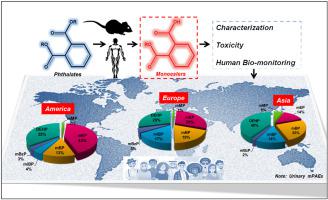Environmental Pollution ( IF 7.6 ) Pub Date : 2021-09-04 , DOI: 10.1016/j.envpol.2021.118106 Ying-Jie Zhang 1 , Jia-Liang Guo 1 , Jing-Chuan Xue 2 , Cui-Lan Bai 1 , Ying Guo 1

|
Phthalates are plasticizers in various products and regarded as endocrine disruptors due to their anti-androgen effects. Environmental occurrence and toxicities of parent phthalates have been widely reported, while the current state of knowledge on their metabolites is rarely summarized. Based on the available literature, the present review mainly aims to 1) characterize the potential metabolites of phthalates (mPAEs) using the pharmacokinetics evidences acquired via animal or human models; 2) examine the molecular and cellular mechanism involved in toxicity for mPAEs; 3) investigate the exposure levels of mPAEs in different human specimens (e.g., urine, blood, seminal fluid, breast milk, amniotic fluid and others) across the globe; 4) discuss the models and related parameters for phthalate exposure assessment. We suggest there is subtle difference in toxic mechanisms for mPAEs compared to their parent phthalates due to their alternative chemical structures. Human monitoring studies performed in Asia, America and Europe have provided the population exposure baseline levels for typical phthalates in different regions. Urine is the preferred matrix than other specimens for phthalate exposure study. Among ten urinary mPAEs, the largest proportions of di-(2-ethylhexyl) phthalate (DEHP) metabolites (40%), monoethyl phthalate (mEP) (43%) and DEHP metabolites/mEP (both 29%) were observed in Asia, America and Europe respectively, and mono-5-carboxy-2-ethypentyl phthalate was the most abundant compounds among DEHP metabolites. Daily intakes of phthalates can be accurately calculated via urinary mPAEs if the proper exposure parameters were determined. Further work should focus on combining epidemiological and biological evidences to establish links between phthalates exposure and biological phenotypes. More accurate molar fractions (FUE) of the urinary excreted monoester related to the ingested diesters should be collected in epidemiological or pharmacokinetic studies for different population.
中文翻译:

邻苯二甲酸酯代谢物:表征、毒性、全球分布和暴露评估
邻苯二甲酸盐是各种产品中的增塑剂,因其抗雄激素作用而被视为内分泌干扰物。邻苯二甲酸酯的环境发生和毒性已被广泛报道,而对其代谢物的当前知识状态很少进行总结。基于现有文献,本综述主要旨在 1) 使用通过动物或人体模型获得的药代动力学证据表征邻苯二甲酸酯 (mPAEs) 的潜在代谢物;2) 检查与 mPAEs 毒性相关的分子和细胞机制;3) 调查全球不同人类样本(如尿液、血液、精液、母乳、羊水等)中 mPAE 的暴露水平;4) 讨论邻苯二甲酸酯暴露评估的模型和相关参数。我们认为 mPAE 与其母体邻苯二甲酸酯相比,由于它们的化学结构不同,其毒性机制存在细微差别。在亚洲、美洲和欧洲进行的人体监测研究提供了不同地区典型邻苯二甲酸盐的人群暴露基线水平。对于邻苯二甲酸盐暴露研究,尿液是比其他样本更受欢迎的基质。在十种尿液 mPAE 中,在亚洲观察到的邻苯二甲酸二(2-乙基己基)酯(DEHP)代谢物(40%)、邻苯二甲酸单乙酯(mEP)(43%)和 DEHP 代谢物/mEP(均为 29%)的比例最大,在美国和欧洲,邻苯二甲酸单 5-羧基-2-乙戊酯是 DEHP 代谢物中含量最丰富的化合物。如果确定了适当的暴露参数,可以通过尿 mPAE 准确计算邻苯二甲酸酯的每日摄入量。进一步的工作应侧重于结合流行病学和生物学证据,以建立邻苯二甲酸酯暴露与生物表型之间的联系。更准确的摩尔分数 (与摄入的二酯相关的尿排泄单酯的F UE ) 应收集在不同人群的流行病学或药代动力学研究中。











































 京公网安备 11010802027423号
京公网安备 11010802027423号